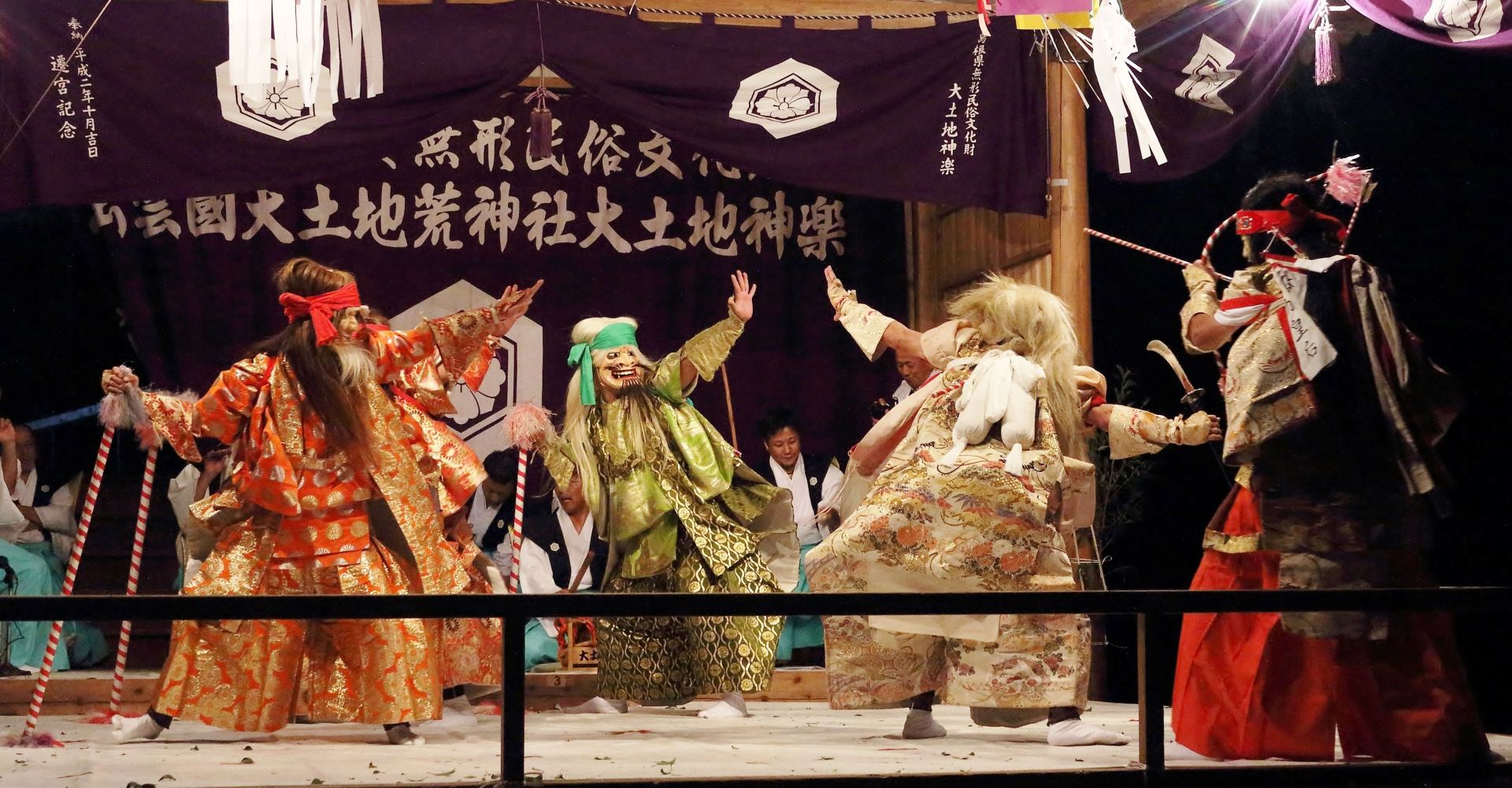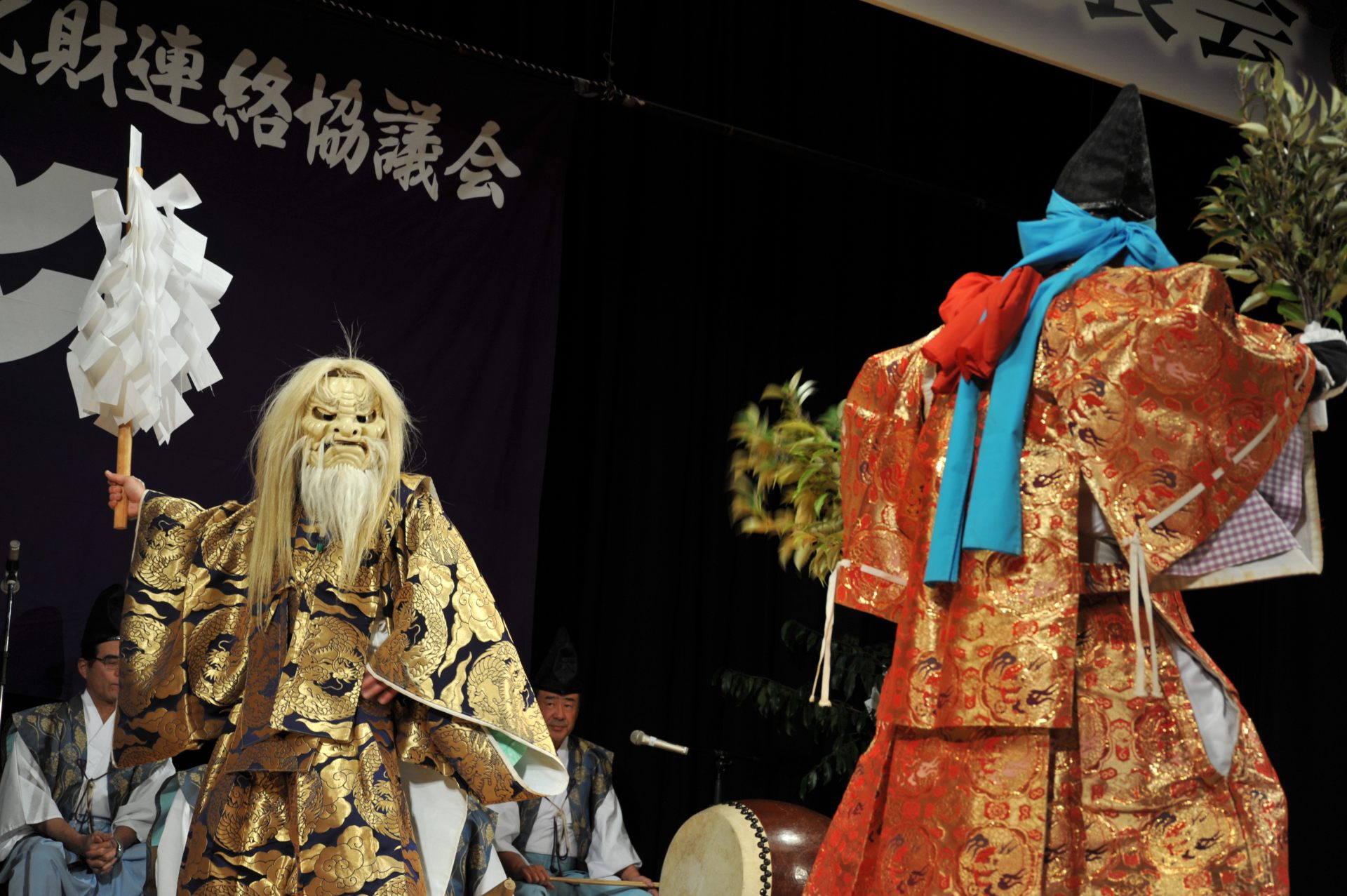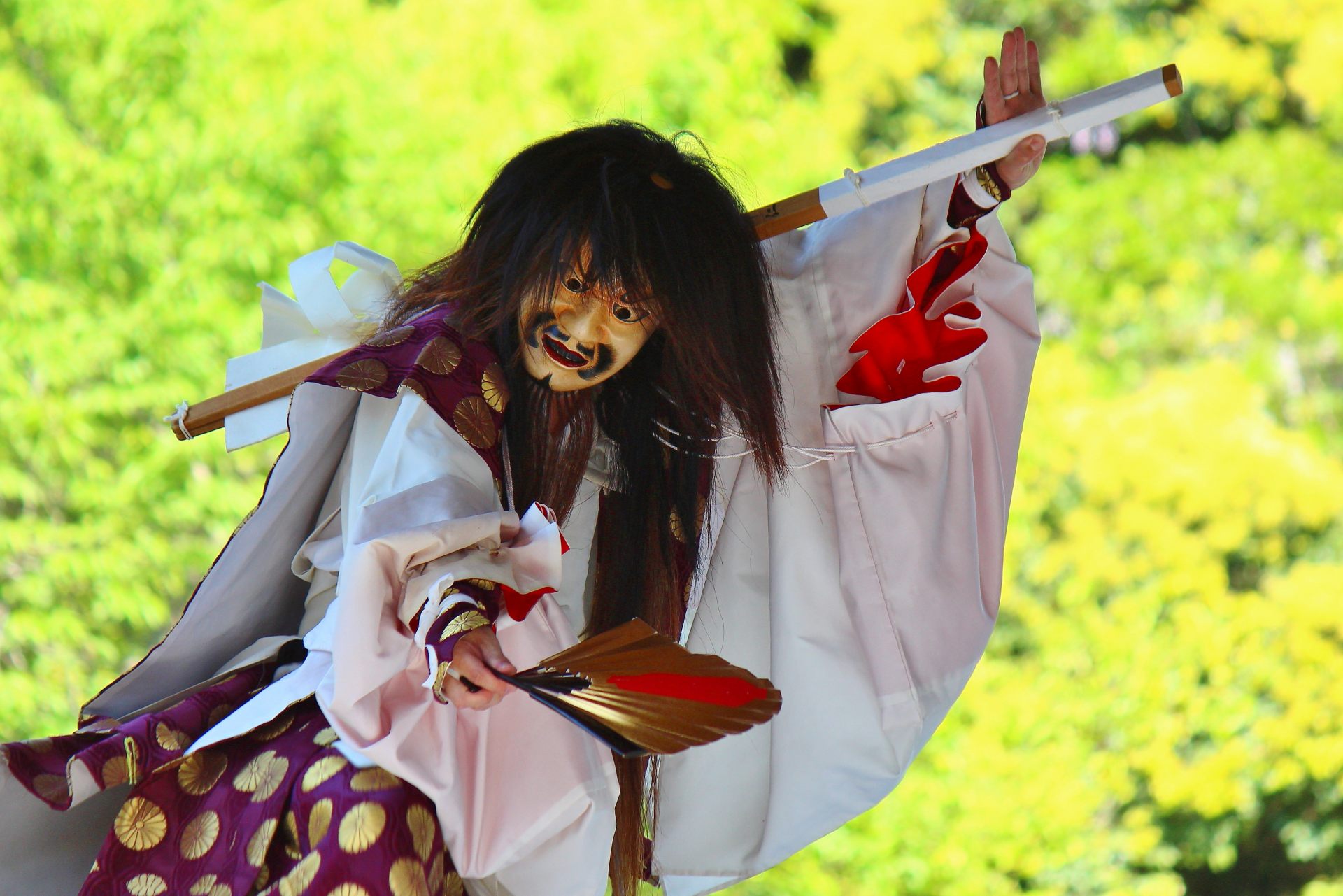
Feast your eyes on Izumo Kagura, the mesmerizing dance for the gods set in Izumo, the land of myth and legend.
Izumo City is shrouded in a mystique, a destination in Shimane Prefecture where you’ll find the grand Izumo Taisha shrine dedicated to the esteemed god of relationships and fortune, Okuninushi-no-Mikoto. A special season each year known as Kamiarizuki, or “month when the gods are present” marks the tenth month of the lunar calendar when the gods of Japan are all said to gather here, making Izumo a legendary region that’s steeped in myth.
Influenced by this mystical backdrop, Izumo Kagura has been passed down through the ages. This sacred dance is performed by Shinto priests in the fascinating, theatrical form of kagura known as “Shin Noh” or “Kami Noh” that first emerged during the Edo period. True to its name, theatric highlights include wearing carved wooden masks while re-enacting the myths of the Izumo region. Even in present day Izumo Kagura is typically held after the autumn harvest season while touring across many shrines in the city, bringing a beloved spectacle to many each year.
Izumo Week is an exclusive event in January 2024 (on any two days among January 29, 30, or 31), that invites guests to witness the full spectacle of Izumo Kagura in a private chamber performance as part of a full expedition "Journey to Izumo, the Land of the Gods - Unraveling Japan's Spiritual Legends & Myth via “Izumo Day”, an All-Exclusive Trip". This special event offers a first-hand chance to relive the many enthralling rituals of Kamiarizuki, as well as a unique opportunity to see all the allures and flair of Izumo Kagura up close.
Table of Contents
- See the age-old drama unfold at this stage shrouded in legend.
- A look at Kagura, the sacred dance passed down by the ancients as a musical gift to the gods during Kamiarizuki, the month said to draw all the gods from across Japan here.
- Izumo Kagura is themed around the myths of Izumo, noted for its vibrant costumes, masks, and wondrous, harmony of musical flair and elegance.
- Regardless of homeland or faith, seeing the ancient Kagura dance up close unlocks the true splendor of Izumo.
- Wrap-Up
See the age-old drama unfold at this stage shrouded in legend
Shimane Prefecture, located along the Sea of Japan, occupies the western part of the San'in region. Izumo makes up for a vast area within the eastern part of the prefecture, famed for its coveted destinations like Lake Shinji, known for shijimi clams. The area is steeped in history, prominently featured in Japan's oldest chronicles, "Kojiki" and "Nihon Shoki," as a stage for numerous myths.
Among the various myths associated with Izumo, the most famous is the "Yamata no Orochi legend." This story details the heroic conquest of the eight-headed serpent, Yamata no Orochi, by the deity Susanoo-no-Mikoto. The legend has deep roots in the area, with several sites related to it, including Susa Shrine, which venerates Susanoo-no-Mikoto and his wife Inadahime-no-Mikoto. Izumo's rich tapestry of mythology continues to be celebrated and remembered through these historic sites and stories.

The famous Kuniumi myth stars Okuninushi-no-Okami as the protagonist, who cedes the land of Izumo to the heavenly gods through negotiation. In exchange, the grand Izumo Taisha Shrine was erected in his honor. The setting of this myth is Inasa no Hama, where Benten Island gently floats in the sea. At sunset, it becomes a prime spot to snap a photo, drawing acclaim from tourists worldwide.

Izumo Taisha is considered a symbol of Izumo, revered as a shrine of matrimonial and fortune deities. With over a thousand years of history, it is a sacred site said to draw all the gods from across Japan during the season of Kamiarizuki, or October by the old calendar. The shrine serves as a fascinating site shrouded in mystique, as it draws travelers from Japan and abroad to this site, dedicated to the chief deity Okuninushi-no-Okami, who also features in the Izumo myths as "Daikoku-sama," known from the Tale of the White Rabbit of Inaba.
Izumo is no stranger to the media across time, inspiring epic dramas and a sense of ancient romance that interlaces legend in and reality. The area also boasts an ancient tradition of Japanese ironmaking "Tatara" and the vibrant cobalt-colored pottery "Izumo-yaki." As you touch upon these cultural heritages, prepare to delight yourself in an expedition across the land blessed by the gods.

A look at Kagura, the sacred dance passed down by the ancients as a musical gift to the gods during Kamiarizuki, the month said to draw all the gods from across Japan here
Kagura refers to one of the rituals performed at a "Kamukura”, a place where the deity is believed to reside, to welcome and entertain the deity at the shrine. Its origins are said to date back approximately 1300 years.
The welcome of the gods is said to harness divine power, believed to enhance vitality and bring prosperity and happiness to both the gods and people. Japan keeps a long history and faith that gods reside in all aspects of nature. In store, Kagura is performed in the sacred halls of shrines and temples as a manifestation of the human desire to connect with nature, preserving a sense of beauty that honors this spiritual communion.
Veteran travelers know that a wide repertoire of Kagura can be found across Japan, but Shimane Prefecture specifically is renowned as one of the country's most active regions for this ancient art, with about 200 Kagura groups continuing the tradition. Over its long history, Kagura has undergone various transformations, leading to the formation of diverse styles and schools, each preserving its unique form in different localities.

Izumo Kagura is a long-loved dance art that reenacts simple and clear stories from Izumo mythology. The "Iwami Kagura" is known for its vibrant performances, featuring costumes interwoven with gold and silver threads, along with the lively beats of drums and the melancholic melodies of flutes. "Oki Kagura" solemnly preserves ancient forms, with dances performed by shrine maidens and others from the shrine in crucial roles. Come to Izumo and its neighboring regions of Iwami and Oki for a feast for the eyes, the kagura dances that still continue to dazzle and enthrall visitors to the region.
Izumo Kagura is of special note, performed just steps from Izumo Taisha Shrine as a key event and piece of ritual culture during Kamiarizuki, the month when the gods of Japan gather in the region. Its solemn and modest dance performances are a significant attraction, imbuing the atmosphere with a sense of reverence and awe.

Izumo Kagura is themed around the myths of Izumo, noted for its vibrant costumes, masks, and wondrous, harmony of musical flair and elegance
The main characteristic of Izumo Kagura is its composition of three types of dances: "Nanaza”, "Shikisanba”, and "Shin Noh”. "Nanaza" involves performances without masks to purify the Kagura space and carries connotations of ritual purification. "Shikisanba" incorporates celebratory songs from Noh theater into its inventive dances, often featuring children as performers. "Shin Noh" is distinguished by its numerous pieces set in the Izumo region.


Kaguyama Kagura is an iconic Izumo Kagura dance, especially famed for depicting the dynamic myth of "Amano-Iwato", where the sun goddess Amaterasu Omikami secluded herself in the Amano-Iwato before being drawn out by the Kasuga Daimyojin and Oyamatsumi no Mikoto in a great venture. The story reveals why the sakaki tree (a type of evergreen) is indispensable in rituals, offering insight into the profound connection between nature and divine in the Shinto belief system.

Additionally, there's a notable Kagura dance depicting Nomi no Sukune, reputed as the forefather of sumo, wrestling with the strongman Taima no Kehaya. This dance vividly portrays the inception of sumo wrestling in Japan. “Ebisu” is another performance that heralds the god of fishing and business prosperity, depicted engaging in sea bream fishing, among various other stories brought to life in these diverse Kagura performances.

The Kagura dances are a true marvel to behold, filmed with intricate details in music, props and costumes that also can’t be missed.
The instruments used in the musical accompaniment include large drums (tsuzumi), small hand-held drums, flutes, hand clappers (copper clappers), and others, varying with each performance. Typically, there is no conductor or musical score; the musicians play in sync with the dancers, watching them and playing in a harmonious understanding, making the relationship among players crucial.
The tools and costumes are truly generational artifacts, often made from expensive fabrics. Many know this iconic art and dance form by the wooden carved masks. In Izumo Kagura, the masks are an integral key of becoming a god or demon in the performance, considered the role of an artisan that carries the vary spirit of the actor in every nuanced step. The masks are colored with a wash of unique paints, while details like beards and eyebrows might be adorned with horse tail hairs, showcasing the meticulous attention to detail. Paying attention to these masks can add another layer of appreciation when viewing Kagura.


Regardless of homeland or faith, seeing the ancient Kagura dance up close unlocks the true splendor of Izumo
Izumo Kagura is embedded with deep allures beneath the surface of each performance, not limited to the marvelous music and costumes used. Even if you don't understand the language, the flair and finesse of dance matched with awe and reverent ambience passed down over generations is undeniably stunning. Once performed as entertainment for travelers, Izumo Kagura fittingly represents the region's cultural heritage.
While this is in fact a sacred ritual there is no worry about imposing as a traveler. Modern Kagura is specifically made to be casually enjoyed by anyone, regardless of faith or hometown. Each performance lasts about 30-40 minutes, and it's possible to leave between acts, so you can experience all the best of Kagura in a relaxed setting. The torchbearers of local Kagura often include residents and those with connections to the area, all committed to preserving and continuing this traditional dance. Some groups even feature children as performers.

Kagura performances are found at a number of different venues, but can be found primarily during shrine festivals, events, and recitals. Performances are held regularly throughout the year so be sure to check the latest performance details on the information page of the Izumo Tourism Association's website. Among the numerous performances, one highly recommended event is the "Izumo City Intangible Cultural Property Presentation," an exposition organized by the Izumo City Intangible Cultural Property Liaison Council, where Kagura troupes from the area come together to perform.

Wrap-Up
Ready for an adventure?
Izumo Kagura is a long-loved tradition since ancient time, celebrating the heritage myth of the gods as they gather in Izumo. Today the same heritage is available in a form of entertainment that you can only find here in Izumo.
